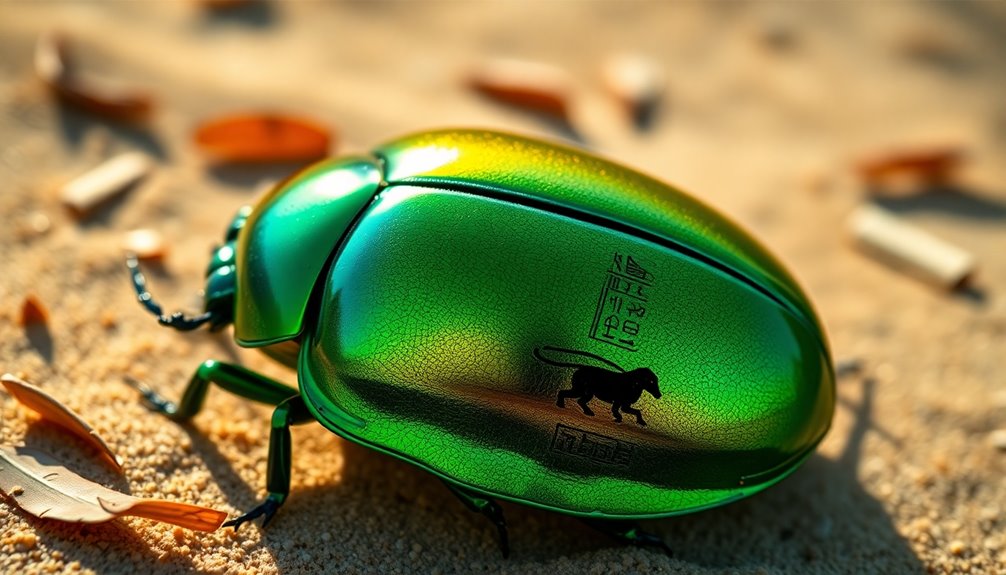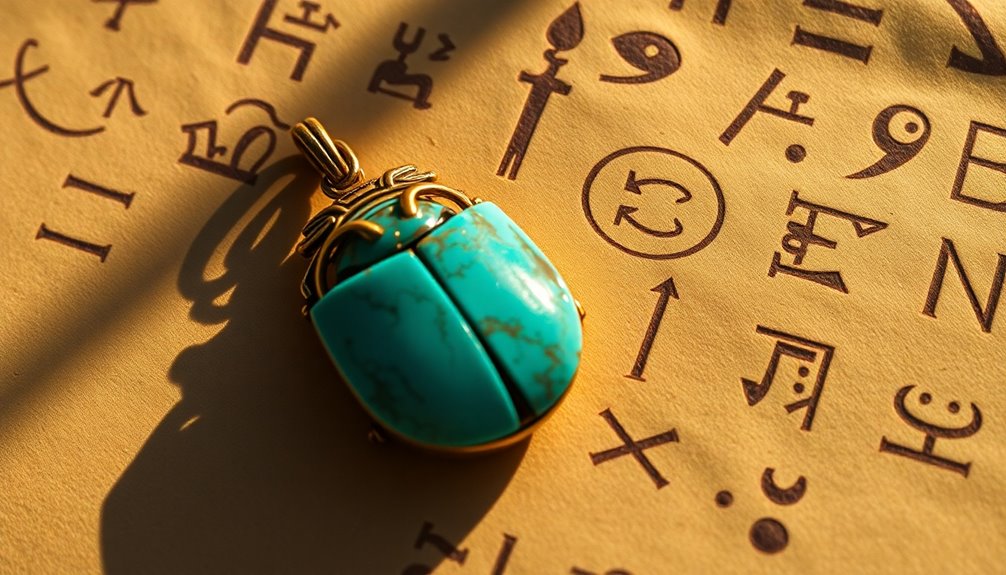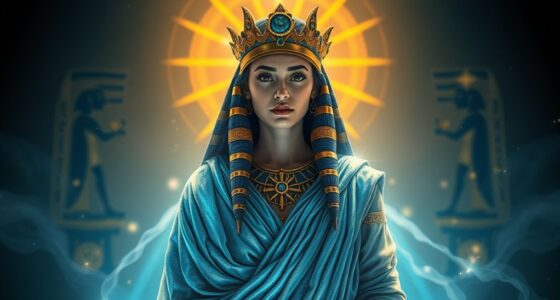The Egyptian beetle, known as the scarab, holds deep meaning. First, it represents transformation and regeneration, tied to the sun god Khepri. You'll find heart scarabs in funerary practices where they played essential roles in protecting the deceased's heart for the afterlife. Finally, today, scarabs inspire modern jewelry, tattoos, and art, linking ancient beliefs with contemporary style. This timeless symbol continues to resonate with themes of protection and good fortune. If you're curious about how these layers of meaning unfold, there's much more to uncover.
Key Takeaways
- The scarab beetle symbolizes transformation and renewal, linked to the sun god Khepri in ancient Egyptian religion.
- Heart scarabs were placed in tombs to protect the deceased's heart during the judgment by Osiris, ensuring safe passage to the afterlife.
- Scarabs evolved from simple seals in the Old Kingdom to intricate decorative objects, reflecting the cultural importance and artistic skill of the time.
- Modern interpretations of scarabs include jewelry and tattoos, symbolizing rebirth and protection while connecting to ancient beliefs.
- The widespread use of scarabs across social classes highlights their significance in governance, funerary practices, and daily life in ancient Egypt.
Cultural Significance of Scarabs
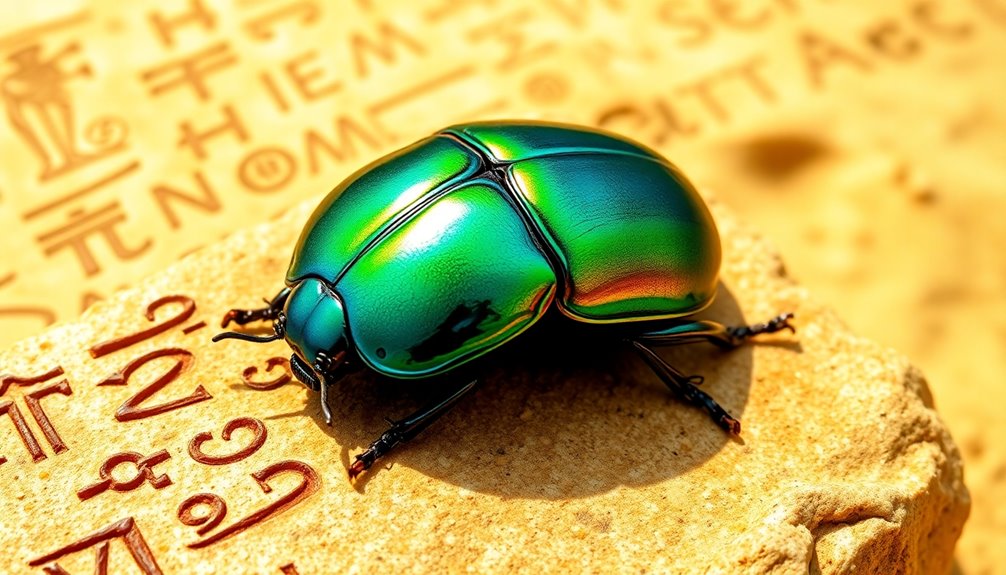
In ancient Egypt, the cultural significance of scarabs was deeply intertwined with concepts of life, death, and rebirth. The scarab, particularly the Scarabaeus sacer, was revered in ancient Egyptian religion as a powerful symbol of transformation and protection.
Associated with the sun god Khepri, who represented the daily renewal of the sun, the scarab embodied the cycle of life and death. You'd notice that the scarab's behavior, rolling dung balls, was seen as a metaphor for regeneration, inspiring worship and reverence.
In funerary practices, heart scarabs played an essential role. These amulets were placed on the deceased's chest during mummification to protect their hearts in the afterlife, ensuring their safe passage.
Scarab amulets were also commonly worn as jewelry, believed to bring protection and good luck. Inscriptions often adorned these amulets to amplify their protective qualities, making them sought after throughout ancient Egyptian history.
The significance of scarabs evolved from simple seals in the Old Kingdom to intricate decorative objects in the Middle and New Kingdoms, symbolizing divine favor and reinforcing their role as a cultural symbol of rebirth.
Symbolism in Funerary Practices
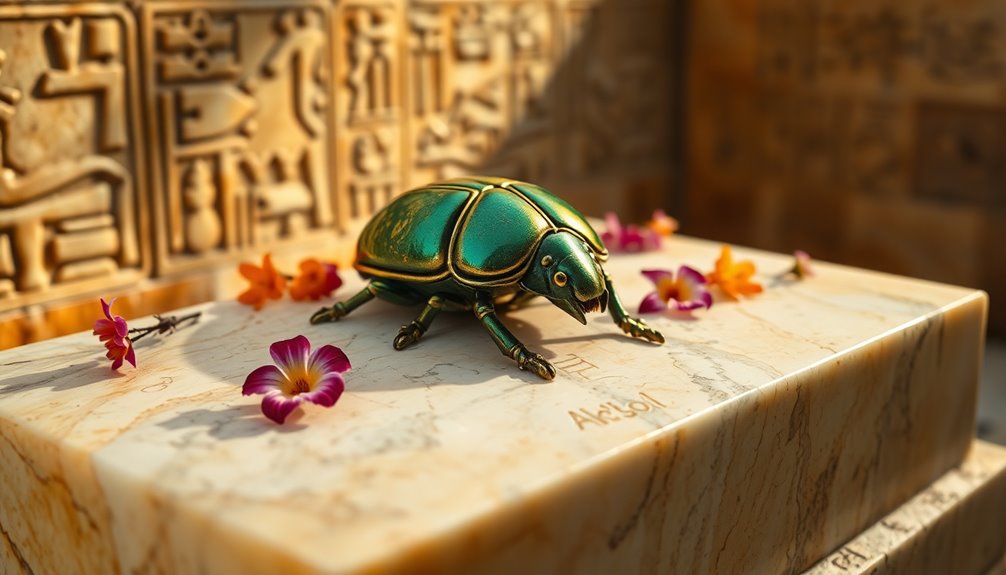
Scarabs played a vital role in ancient Egyptian funerary practices, symbolizing protection and renewal for the deceased. The scarab beetle wasn't just an insect; it embodied the ancient Egyptians' hope for a safe afterlife journey.
Here are three key aspects of their symbolism in funerary rituals:
- Heart Scarabs: These amulets were placed on the chest of the deceased during mummification. They protected the heart, which was essential for the judgment of Osiris, ensuring the soul's safe passage.
- Funerary Scarabs: Commonly found in burial rituals, these scarabs often featured inscriptions invoking protective spells. They served as guardians, ensuring blessings for the deceased in the afterlife.
- Weighing of the Heart: Scarabs were believed to guard the heart during the weighing ceremony, where its purity was evaluated against the feather of Ma'at. This ritual was vital for achieving resurrection and eternal life.
The inclusion of scarabs in tombs highlights the deep-seated beliefs of ancient Egyptians in the symbolism of protection, resurrection, and the hope for life beyond death.
Modern Interpretations and Uses
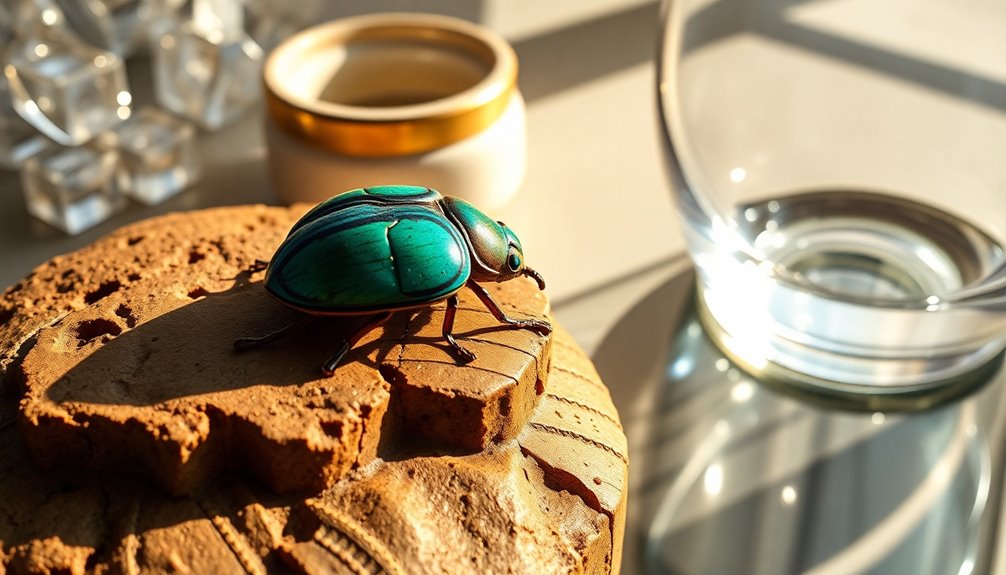
Beyond their ancient origins, scarabs have found a vibrant place in modern culture, seamlessly blending tradition with contemporary aesthetics. You'll see the scarab symbol prominently in jewelry pieces, often crafted from gold, silver, and gemstones. These pieces represent protection and good fortune, allowing you to carry a piece of ancient Egyptian heritage with you.
Many tourists purchase scarab replicas and amulets as souvenirs, showcasing their enduring significance. These items serve as tangible connections to the past, embodying the powerful meanings associated with the scarab.
Additionally, scarab tattoos have surged in popularity, symbolizing rebirth and transformation, reflecting a deep spiritual connection to ancient beliefs.
Modern interpretations of scarabs frequently incorporate contemporary artistic styles while maintaining their traditional roots. You'll find them in decorative items and home decor, where their timeless appeal shines. The symbolism of the scarab echoes the importance of protection and good fortune in various cultures, reinforcing its relevance today.
Whether you're drawn to their historical significance or their aesthetic charm, scarabs continue to resonate in today's world. Embracing these symbols not only honors ancient traditions but also invites a sense of protection and renewal into your life.
Frequently Asked Questions
What Does the Egyptian Beetle Symbolize?
The Egyptian beetle, or scarab, symbolizes rebirth and transformation. When you think about its connection to the sun god Khepri, you realize it represents daily renewal.
In ancient Egyptian culture, these beetles were seen as protectors, often crafted into amulets to ward off evil. Their behavior of rolling dung also signifies the cycle of life and death, reminding you of fertility and regeneration, making them powerful symbols throughout history.
What Does the Scarab Beetle Symbolize Spiritually?
The scarab beetle symbolizes rebirth and transformation spiritually.
You'll see it represents the daily renewal of the sun, linking it to the god Khepri. This beetle's behavior of rolling dung balls reflects the cyclical nature of life and death, emphasizing resurrection.
In ancient beliefs, scarab amulets protected against death and illness, offering hope for a safe journey in the afterlife.
What Is the Meaning of the Egyptian Winged Scarab Beetle?
The Egyptian winged scarab beetle symbolizes rebirth and resurrection, reflecting the cycle of life and death.
When you look at it, think of the journey to the afterlife and the divine protection it offers to the deceased.
Its wings represent the soul's flight, signifying liberation and hope for eternal life.
You'll often see scarabs in art and jewelry, reminding you of the connection to the divine and the promise of good fortune.
What Is the Secret Beetle in Egypt?
Imagine the secret beetle in Egypt as a tiny guardian of the afterlife, the scarab beetle.
Revered for its role in rebirth, it symbolizes transformation and renewal. You'll find heart scarabs placed on the deceased, protecting them during their journey to judgment.
Scarab beetles also represent the cycle of life, rolling dung as a metaphor for existence. Worn as amulets, these beetles offer good luck and ward off evil, embodying ancient Egyptians' beliefs.
Conclusion
In conclusion, the Egyptian beetle, or scarab, holds a profound significance that spans centuries. Did you know that over 80% of ancient Egyptian tombs contain scarab artifacts? This statistic highlights their essential role in funerary practices and cultural symbolism. Today, people still draw inspiration from these ancient symbols, using them in jewelry and art to connect with their rich history. Embracing the scarab allows you to tap into a legacy of protection, transformation, and rebirth.

